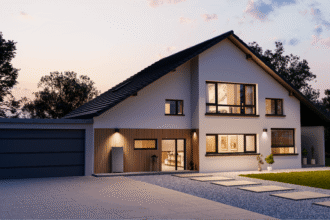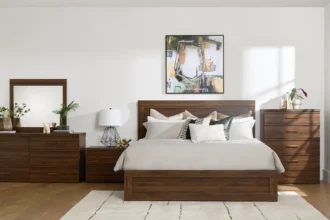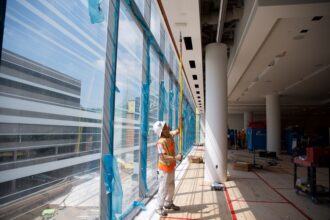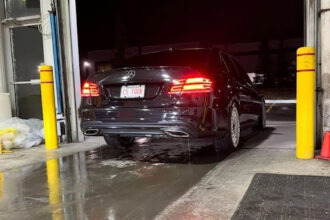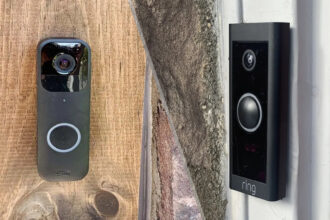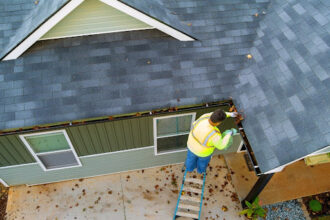Did you know 70% of homeowners overlook railings as critical safety features when planning outdoor spaces? In Alberta’s climate, this oversight can lead to costly repairs—or worse, accidents. Your railing system isn’t just a guardrail. It’s the finishing touch that transforms your space into a safe, stylish oasis.
Edmonton’s freeze-thaw cycles demand materials that laugh at -30°C winters. River Valley views deserve frames that enhance—not block—nature’s artwork. Modern glass panels? Classic wrought iron? Low-maintenance composites? Each choice impacts safety, aesthetics, and your home’s value.
This guide cuts through the noise. We’ll explore how local weather patterns influence durability needs. You’ll discover design trends popping up in Glenora and Terwillegar neighborhoods. Most importantly, you’ll learn how to balance municipal codes with personal style—because your outdoor space should protect and impress.
Why Deck Railings Matter for Edmonton Homes
Your deck railing does more than frame your outdoor space – it’s the silent guardian that balances protection with personality. In Edmonton’s dynamic environment, this essential feature faces unique challenges that demand smart solutions.
Safety Meets Curb Appeal
Railings prevent falls while shaping your home’s character. The sweeping river vistas in Laurier Heights call for transparent glass panels, while industrial-inspired neighborhoods might favor bold metal designs. Every choice tells your home’s story.
Edmonton’s Unique Climate Considerations
Our -40°C winters and summer heatwaves test materials differently than coastal climates. Frost heave protection becomes critical as frozen ground shifts deck foundations. Durable options like powder-coated aluminum withstand temperature swings better than untreated wood.
Local Building Code Requirements
Edmonton follows strict Alberta building codes for deck safety:
| Feature | Requirement | Purpose |
| Height | Minimum 36″ | Prevent falls |
| Spacing | Max 4″ between balusters | Child safety |
| Materials | Load-rated components | Snow weight support |
Decks over 30″ high must have railings – no exceptions. These rules ensure your space stays safe through blizzards and heatwaves alike.
Key Factors When Choosing Deck Railings
Choosing the right deck railing is more than just picking a style. It’s about finding a balance between function and beauty in Edmonton’s climate. Let’s look at three key things to consider when making your choice.
Material Durability
Edmonton’s weather can be extreme, with temperatures dropping to -40°C in winter and rising to +30°C in summer. This means you need extreme weather resistance. Powder-coated aluminum is better than untreated wood in these conditions, as seen in Windermere homes.
Moisture protection also matters:
- Composite materials resist warping
- Stainless steel hardware prevents rust
- Pressure-treated wood needs annual sealing
Maintenance Requirements
In Glenora, homeowners spend 15 hours a year staining wood railings. In contrast, aluminum railings only need 2 hours of cleaning. Here’s a comparison of long-term commitments:
| Material | Annual Time | 10-Year Cost | Durability |
| Cedar | 12 hours | $2,800 | Medium |
| Aluminum | 3 hours | $1,200 | High |
| Composite | 5 hours | $1,800 | High |
Visual Harmony
Heritage home railings in Old Strathcona often match the Craftsman bungalows with detailed woodwork. Modern infills in Blatchford prefer sleek glass panels. Think about:
- Roof pitch alignment
- Window trim coordination
- Dominant neighborhood materials
Southwest communities often choose mixed metal-and-wood designs. Mature areas stick to traditional vertical balusters.
Top Material Options for Edmonton Deck Railings
Edmonton’s changing seasons mean deck materials need to be both beautiful and strong. We’ll look at four popular railing types, their benefits, and how they handle our cold winters and warm summers.
Wood Railings
Pros: Natural Warmth, Customizable
Cedar and pressure-treated pine are favorites for their natural look. Wood works well for curved decks or detailed designs, fitting well with heritage homes. TimberTown offers FSC-certified wood for those on a budget.
Cons: Annual Sealing Required
Edmonton’s weather can cause untreated wood to warp. You’ll need to seal it every year to prevent damage.
Best Uses: Traditional Homes, Budget Projects
Wood is great for Craftsman-style homes or as a temporary fix while saving for better materials.
Metal Railings (Aluminum/Wrought Iron)
Pros: Low Maintenance, Modern Look
Aluminum deck railings Edmonton residents prefer because they don’t rust in heavy snow. Powder-coated finishes in matte black or bronze are modern and durable. Wrought iron adds elegance but needs more care.
Cons: Cold Weather Conductivity
Metal can get icy quickly. Use composite caps or gloves in winter.
Best Uses: Contemporary Designs, High-Wind Areas
Aluminum is light and strong, perfect for rooftop decks or windy areas near Whitemud Creek.
Glass Panel Systems
Pros: Unobstructed Views, Weather-Resistant
Tempered glass panels from Home-Rail stay clear even in -40°C. Frameless designs offer great views and block snow.
Cons: Higher Cost, Cleaning Needs
Costs around $90-$120 per foot installed. Clean with vinegar weekly to fight winter grime.
Best Uses: River Valley Properties, Modern Builds
Popular in areas like Laurier Heights and Glenora for their scenic views.
Composite Materials
Pros: Fade-Resistant, Splinter-Free
Recycled plastic-wood blends are durable and won’t warp. Trex offers textured finishes that look like real wood.
Cons: Limited Color Options
Most composites are gray or earth tones. Be wary of Alberta-market fakes without UV stabilizers.
Best Uses: Family Homes, Low-Maintenance Yards
Great for families or seniors needing safe, easy-to-clean surfaces.
| Material | Lifespan | Winter Performance | Local Suppliers |
| Wood | 10-15 years | Needs annual sealing | TimberTown |
| Aluminum | 25+ years | No rust/salt damage | Home-Rail |
| Tempered Glass | 20+ years | No fogging | Home-Rail |
| Composite | 15-20 years | Fade-resistant | Verify UL certification |
Popular Deck Railing Styles in Edmonton
Edmonton’s neighborhoods show off railing designs that mix local charm with modern needs. Whether you’re fixing up an old home or starting a new one, these styles have something for everyone.
Modern Horizontal Designs
Clean lines are big in Edmonton’s newer places, with horizontal railings giving clear views of rivers and cities. They’re perfect for rooftop decks and high-up patios.
Example: Powder-coated aluminum slats
Oliver’s high-rise balconies often use this easy-to-care-for option. It’s great because:
- It stands up to extreme temperatures
- You can pick colors for bold accents
- It needs 50% fewer vertical supports than old designs
Traditional Vertical Balusters
Wood-and-iron styles are loved in older areas like Bonnie Doon. They match Edmonton’s old buildings and meet today’s safety rules.
Example: Pressure-treated pine with wrought iron accents
This mix offers:
- Wood that looks good as it gets older
- Iron for extra style
- It works well in snowy weather
Mixed Material Combinations
Mixed material railings are great for Edmonton’s new homes, mixing old and new looks. They let homeowners show off their home’s special features.
Example: Glass panels with stainless steel frames
Modern homes near Whyte Avenue often use these to:
- Keep views of old brick buildings
- Make barriers that last
- Let in natural light on smaller decks
Edmonton-Specific Considerations
Building a deck in Edmonton needs careful thought about local weather and rules. We’ll look at three key points to make sure your deck is safe and fits in with the community.
Snow Load Requirements
Edmonton gets a lot of snow, so railings must handle 50+ pounds per square foot of snow. Places like Terwillegar need stronger designs because of wind tunnels. But, sheltered areas might just need standard supports. Here’s a table showing the differences:
| Area | Minimum Snow Load | Recommended Railing Material |
| Terwillegar | 60 PSF | Powder-coated aluminum |
| Downtown | 50 PSF | Tempered glass panels |
| River Valley | 55 PSF | Composite with steel core |
Permit Process Overview
Getting Edmonton deck permits involves four steps:
- Submit blueprints showing railing height (36″ minimum)
- Pay the $120 application fee online
- Schedule a materials inspection within 10 business days
- Receive final approval after installation
Local Contractor Recommendations
These certified installers meet Edmonton’s CSA standards:
- Prairie Deck Builders (15 years experience)
- Northern Railcraft Ltd. (specializes in frost-resistant footings)
- Capital City Carpentry (offers 5-year warranties)
Installation Tips for Edmonton Climates
Edmonton’s weather changes a lot, making it important to install deck railings right. Installing in June lets materials adjust before winter. But, installing in September might be too rushed as frost comes.
Professional vs DIY Approach
Complex jobs need experts. If your deck is:
- Multi-level with steep slopes
- Has custom glass panels
- Includes integrated lighting
DIY-Friendly Options
Prefab railing kits make weekend projects easy. Brands like Veranda and Trex offer:
- Pre-drilled holes for easy mounting
- Adjustable sleeves for posts
- Fasteners that resist the weather
Winterization Techniques
Get your railings ready for -40°C with these tips:
Expansion Gap Best Practices
Make sure to leave 1/8″ gaps between metal parts. They will shrink in winter. Use nylon spacers to keep the gaps even.
Anti-Ice Measures for Glass Panels
Keep ice off glass panels with these tips:
- CRC Ice-Off spray (safe for metal)
- Frost King heated cables (good for rail bases)
- SlipShield clear coating for traction
Maintenance Guide for Longevity
Keeping your deck railing in top shape is key to a safe and beautiful outdoor area. Edmonton’s weather can be tough, but with the right care, your deck will last longer. Follow our seasonal tips and proactive steps to protect your investment.
Seasonal Cleaning Routines
Begin with a spring power-wash to get rid of dirt and salt. Use a gentle detergent and a soft-bristle brush for materials like wood or composite. In fall, check your sealants for cracks and reapply if necessary. This stops moisture from getting in during cold weather.
- April: Clear debris from rail gaps
- June: Check for insect damage
- October: Test fastener tightness
Damage Prevention Strategies
Start with weather-resistant sealants from Edmonton Rona stores for freeze-thaw protection. For metal railings, apply anti-rust coatings every year. Fix small problems fast to avoid expensive repairs later:
| Issue | Resealing Cost | Replacement Cost |
| Minor cracks | $40–$80 | $300+ |
| Warped panels | N/A | $150–$400 |
Using products like Rona’s All-Climate Guard can help even more. A quick 10-minute check each month can save you a lot of money on repairs!
Conclusion
Choosing the right deck railings is key. It mixes usefulness with style. Options like durable composites and sleek glass panels fit Edmonton’s climate well. They also make outdoor areas better.
Installing and keeping your railings right is important. It ensures they meet safety standards. This is vital for safety and following the law.
Upgrading your home with quality railings can pay off. Studies show homeowners can get 5-8% of their costs back in property value. Trusted suppliers offer 10-25 year warranties on their work and materials.
They also check your deck’s snow load and help with permits. Your deck can be a valuable part of your home all year. Look into custom options that are weather-proof yet stylish.
Book a consultation to make your outdoor space more valuable. It will be perfect for Edmonton’s changing seasons.



